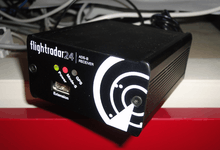Flightradar24
 | |
Type of site | Monitoring of aircraft |
|---|---|
| Available in | English |
| Headquarters |
|
| Country of origin | Sweden |
| Owner | Flightradar24 AB |
| Website | Flightradar24.com |
| Alexa rank |
|
| Commercial | Partially |
| Registration | Freemium |
| Launched | 2006 |
| Current status | Active |
Flightradar24 is a Swedish internet-based service that shows real-time aircraft flight information on a map. It includes flight tracks, origins and destinations, flight numbers, aircraft types, positions, altitudes, headings and speeds. It can also show time-lapse replays of previous tracks and historical flight data by airline, aircraft, aircraft type, area or airport. It aggregates data from multiple sources but, outside of the United States, mostly from crowdsourced information gathering by volunteers with ADS-B receivers. The service was founded as a hobby in 2006 by two Swedish aviation enthusiasts.[1] It is available via a web page or mobile device apps. The Guardian considers the site to be "authoritative".[2]
Tracking

Flightradar24 aggregates data from three sources:[3]
- Automatic dependent surveillance-broadcast (ADS-B). The principal source is a large number of ground based ADS-B receivers, which collect data from any aircraft in their local area that are equipped with an ADS-B transponder and feed this data to the internet in real time. The aircraft-based transponders use the GPS and other flight data input to transmit signals containing aircraft registration, position, altitude, velocity and other flight data. Currently, about 65% of aircraft in Europe are equipped with ADS-B but only 35% in the US. For example: all Airbus aircraft are ADS-B equipped but Boeing 707, 717, 727, 737-200, 747-100, 747-200, 747SP do not come equipped and are not generally visible unless retrofitted by their operators. Typical ADS-B receivers include Kinetic Avonics′s SBS-1 and AirNav-systems's AirNav and these receivers are run by volunteers, mostly aviation enthusiasts. ADS-B signals can also be received and uploaded by a low-cost Software-defined radio, such as those based on the $15 R820T tuner.[4]
- Multilateration (MLAT). The second major source is multilateration using Flightradar24 (FR24) receivers. All aircraft types will be visible in areas covered by MLAT, even without ADS-B, but while 99% of Europe is covered, only parts of the US are. At least four receivers are needed to calculate the position of an aircraft.[3]
- Federal Aviation Administration. The shortfall in the US is mostly made up from 5 minute delayed data from the Federal Aviation Administration (FAA) but this may not include aircraft registration and other information.
Privacy
The site blocks some ADS-B information from display for "security and privacy" purposes.[3] For instance, the position of the Japanese Air Force One aircraft used by the Japanese emperor and prime minister was visible on the site until August 2014, when the Japanese Ministry of Defense requested that the information be blocked.[5] This has subsequently meant that the aircraft no longer has its flight track posted online or on the site.
History
The service was founded by two Swedish aviation enthusiasts in 2006 for Northern and Central Europe, who then opened it up to, allowing anyone with a suitable ADS-B receiver to contribute data in 2009.[1] The service received extensive exposure in 2010 when international media relied on it to describe the flight disruption over the north Atlantic and Europe caused by the Eyjafjallajökull volcano eruptions.[6][7][8]
In 2014 it was used by multiple major news outlets following several high profile crashes. The disappearance of Malaysia Airlines Flight 370,[9] and in July 2014 after Malaysia Airlines Flight 17 was shot down over Ukraine,[10] and in December when Indonesia AirAsia Flight 8501 went missing. Flightradar24 reported that its web traffic increased to around 50 times normal and caused some access congestion to users.
In November 2015, The Guardian newspaper reported that Kogalymavia Flight 9268 on route to Saint Petersburg from Sharm el-Sheikh International Airport had broken up in the air based on information available from FlightRadar24.[2]
References
- 1 2 "About". FlightRadar24.
- 1 2 Siddique, Haroon; Luhn, Alec (1 November 2015). "Russian plane 'broke up in air' before Sinai crash". The Guardian. Retrieved 1 November 2015.
- 1 2 3 "How it works". Flightradar24. Retrieved 26 July 2014.
- ↑ "RTL-SDR Tutorial: Cheap ADS-B Aircraft RADAR". rtl-sdr.com. 13 April 2013. Retrieved 26 March 2015.
- ↑ 政府機のルート筒抜け アプリに位置情報など表示 (in Japanese). Nihon Keizai Shimbun. 4 September 2014. Retrieved 4 September 2014.
- ↑ "Icelandic volcano: UK flight disruption". The Guardian. 15 April 2010. Retrieved 12 April 2015.
- ↑ "Nu stoppas flygen" [Planes being stopped now] (in Swedish). Expressen. 15 April 2010. Retrieved 26 March 2015.
- ↑ "El norte de Europa se recupera" [Northern Europe recovers] (in Spanish). El País. 19 April 2010. Retrieved 26 March 2015.
- ↑ "Malaysia Airlines MH370 disappears from air traffic map". BBC News. 11 March 2014. Retrieved 26 March 2015.
- ↑ "Malaysia Airlines MH17 flight path map". The Guardian. 18 July 2014. Retrieved 18 July 2014.
External links
- Official website
- FlightRadar24 Forum
- Last positions of #MH17 directly from Flightradar24 database. Signal was lost around 13:21 UTC at 33,000 feet.